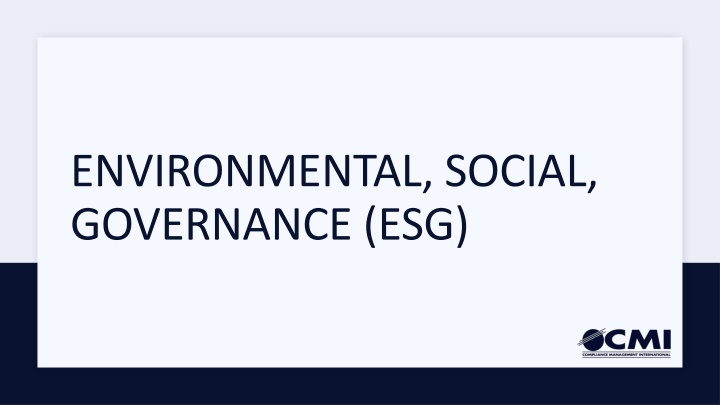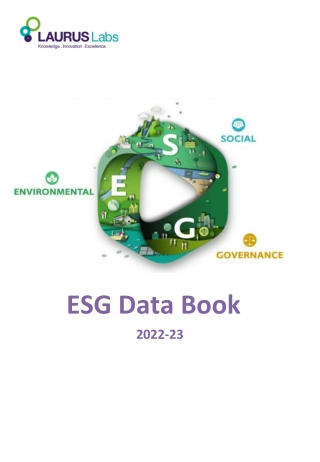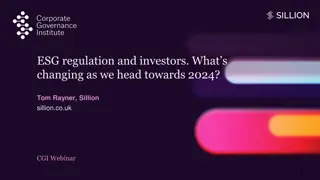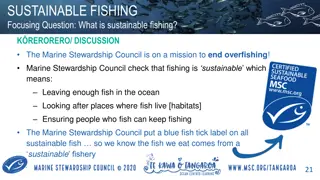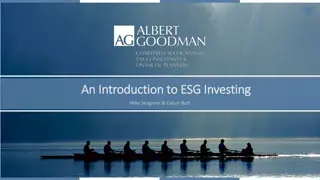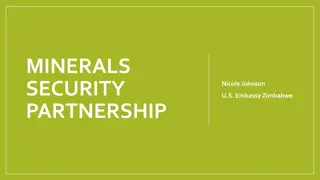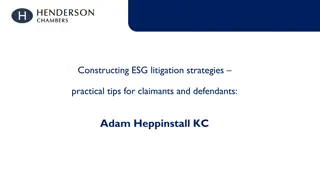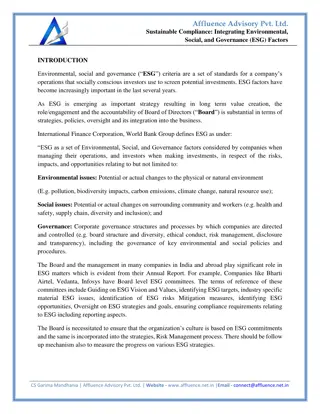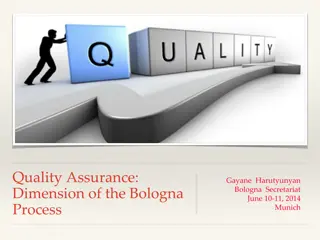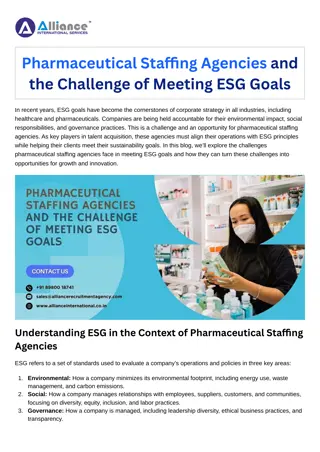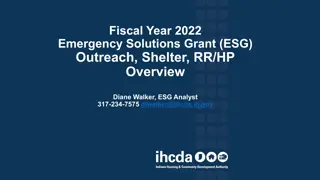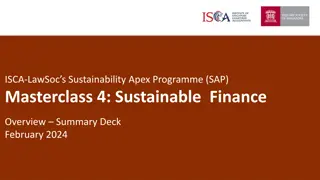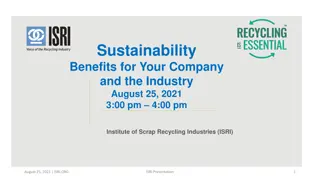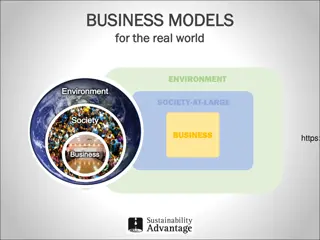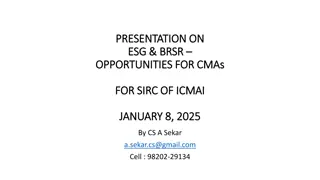ESG for Sustainable Business Practices
ESG, encompassing Environmental, Social, and Governance factors, plays a crucial role in evaluating a company's impact on the planet, society, and accountability. It serves as a framework for measuring sustainability and transparency in business operations. Learn about the significance of ESG, its reporting requirements, typical focus areas, and how to develop a plan involving key stakeholders within a company. Explore the historical context and global initiatives driving ESG adoption, and understand the importance of being involved in ESG reporting for global markets and customer demands.
Download Presentation

Please find below an Image/Link to download the presentation.
The content on the website is provided AS IS for your information and personal use only. It may not be sold, licensed, or shared on other websites without obtaining consent from the author.If you encounter any issues during the download, it is possible that the publisher has removed the file from their server.
You are allowed to download the files provided on this website for personal or commercial use, subject to the condition that they are used lawfully. All files are the property of their respective owners.
The content on the website is provided AS IS for your information and personal use only. It may not be sold, licensed, or shared on other websites without obtaining consent from the author.
E N D
Presentation Transcript
ENVIRONMENTAL, SOCIAL, GOVERNANCE (ESG)
PRESENTER KRISTIAN WITT VICE PRESIDENT, ENVIRONMENTAL SERVICES KWITT@COMPLIANCEPLACE.COM 267-303-9319
HOUSEKEEPING This presentation is being recorded and will be shared. Everyone will be muted to prevent background noise. Use the question button to log your question.
1. What is ESG? 2. Are you required to participate? 3. What are typical areas of focus? TODAY S TOPICS 4. Developing a plan? 5. Who in your company should be involved? 6. Develop Key Performance Indicators
HOW DID WE GET HERE? 2015-2017 UN Sustainability Goals, Global Reporting Initiative (GRI), and The Compact for Responsive and Responsible Leadership 2011 Jean Rogers founded the Sustainabili ty Accounting Standards Board (SASB) 1987 World Commission on Environment and Development Report 2006 The Corporate Responsibility started in the 1950s Principles for Responsible Investment Current Status
WHAT IS ESG? Framework to measure a company's impact on environment society how transparent and accountable it is Used as an investing tool Mandatory Reporting Global Markets Recalibrates Risk
DO I NEED TO BE INVOLVED AND WHY Most Likely at some level Corporate Reporting Customer Surveys Rating Platforms EcoVadis CDP And more ESG reporting is a Global Effort Important customers may demand it
ENVIRONMENTAL A Company s impact on the planet Use of Natural Resources Bio Diversity Carbon emissions as well as Criteria and Hazardous Air Pollutants Solid Waste Water use and wastewater Energy
ENVIRONMENTAL NATURAL RESOURCES Renewable Energy Sources Reduce and recycling programs Alternative Raw Materials Control Technologies Hazardous Materials Product End of Life Consumption Optimization
ENVIRONMENTAL BIODIVERSITY Variety and Variability on Life Impact of operations on species Loss poses a risk to the environment Habitat Destruction Invasive Species Not straightforward Outside resource and support will be needed
WHAT IS YOUR CARBON FOOT PRINT AND MORE Greenhouse Gas Emissions Scope 1 Direct Combustion, Refrigerant Leaks, Process emissions Scope 2 Indirect Energy Consumption Scope 3 Supply Chain Upstream and Downstream 15 Categories Other air emissions and reduction efforts
WASTE MANAGEMENT Reduce Reuse Recycling Recovery Employee Training
WATER Water Consumption Recycling Discharge Volume Contamination Stormwater No Exposure Treatment
ENERGY Consumption Renewable Energy Efficiency Renewable Credits Related to Carbon foot print
OTHER ENVIRONMENTAL ISO14001 EMS Responsible Care ECO Certifications
SOCIAL TOPICS Employee Relations Worker Conditions Training Supply Chain labor practices Diversity Sustainability Legal Requirements
WORKER CONDITIONS Safe Work Practices Working Conditions Labor Relations DEI Wages
WORKER TRAINING Waste reduction Air emissions Energy conservation Water conservation Hazardous materials handling Health and Safety Risks Subcontractor/Temp Employees
GOVERNANCE How an organization is governed? Risks and opportunities in decision making What are the responsibilities of Participants in an organization? Board of Directors Managers Shareholders Stakeholders Organization Transparency It is an indication of Risk in the ability to capitalize on business opportunities.
WHAT NOW DEVELOP A PLAN Establish your ESG Team Cross functional Identify Key ESG issues What factors are most relevant Carbon Footprint Waste Labor Engage Stakeholders Internal and Stakeholders Establish most impactful ESG issues Set ESG Goals and KPIs Action Plan
WHAT NOW DEVELOP A PLAN CONT. Implement and Integrate Company Policies Operations must incorporate ESG into business decisions, processes, SOPs Company Culture Engage and train employees Track Progress Monitor against KPIs Adjust Report Continuous Improvement Living Effort Bench mark against industry standards
WHO IS INVOLVED ESG Lead External Advisors/ Consultants EHS HR IT Finance Purchasing
KEY PERFORMANCE INDICATORS Establish Smart Goals and KPIs GHG emissions next year, all energy purchased will be renewable. Water All water will be recycled in 5 years Waste Reduce waste by 50% Zero hazardous waste. Bio Diversity Protect habitat and reduce deforestation Health and Safety incident Reduction Increase Training hours
Questions? Thank You.
GET IN TOUCH: KWITT@COMPLIANCEPLACE.COM WWW.COMPLIANCEPLACE.COM
